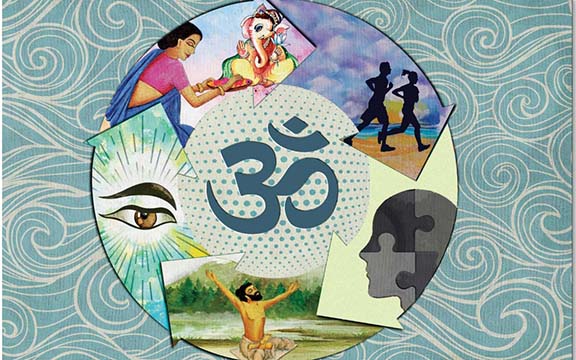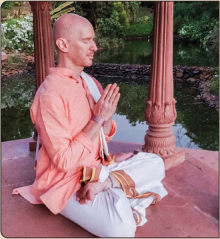
Original artwork by Baani Sekhon.
In the last installment of this six-part series, Eddie Stern brings his analysis of Yoga and neuroscience to a close and a final, very illuminating conclusion.
Let’s come back to Kriya Yoga to pull this all together. The components of Kriya Yoga, as mentioned earlier, are tapas, svadhyaya and Ishvara pranidhana.
Tapas
Swami Hariharananda Aranya, in his commentary on Vyaasa’s bhashya on the Yoga Sutras, states that tapas is physical, svadhyaya is verbal and Ishvara pranidhana is mental. The practices of tapas include asanas and pranayama, which affect physiological functions. Asanas are done not just to make the body strong and flexible, but to exert a deliberate pressure on internal organs and nerves that send messages directly to the brain, particularly the brain stem. For example, the gut-brain axis is the communication network of the microbes of the gut communicating through the vagus nerve (the primary nerve complex of the parasympathetic nervous system) back to the brain to tell the brain the condition of the gut. Many of the twisting asanas, and postures such as mayurasana are providing a deep stimulation to the abdominal viscera which are messaging directly to the brain.
The heart, lungs, liver, pancreas, stomach, diaphragm and intestines are all receiving messages from the brain, and also sending messages to the brain, through the vagus nerve. When we massage, stimulate and change pressure to these organs, when we encourage blood circulation and oxygenation to these organs, that message of life and vitality is sent to the brain. This keeps our operating system in balance, healthy and filled with vitality.
The health of the communication systems from the body to the brain stem supports homeostasis, the body’s ability to constantly restore balance in relationship to the changing environment that we live in. Thus, the physical practices associated with tapas are directly affecting brain stem functions. The yogis who can stop their heartbeat, stop their breathing, control their sleep, withstand either freezing or extremely hot temperatures, go without food for extremely long periods or digest anything they ingest, are controlling brain stem functions. This is tapas.
Svadhyaya
Svadhyaya is self-evaluation and the repetition of mantras. One of the key aspects of svadhyaya is bhavana, the devotional mood or emotion associated with spiritual practices. The experience of mood and emotion is tightly linked to the limbic system. Swami Hariharananda has stated that without developing bhavana, the deeper levels of meditation cannot occur. Through the practice of svadhyaya, we address the area of the brain that processes and cements the narrative we have created about ourselves based on fear and emotions. The likes, dislikes, attractions and aversions of raga and dvesha are cemented here as repeated, habitual responses to the constructed world we live in.
Ishvara Pranidhana
While the brain stem primarily performs operations for the sake of keeping us alive, the limbic system processes information that keeps the sense of identity alive, but an identity based not on Self-referral but the object referral of the constructed self. Fear, memory and emotions are all processed in the limbic system. They are responses to actions, experiences, impressions and the desires to either move toward or move away from one of those experiences.
The repetition of mantras and self-evaluation breaks the cyclical narrative we often have rolling through our heads, and replaces that narrative with the syllables of transcendent thought (mantras) and the ability to observe how and when our likes and dislikes rear their heads. We can train ourselves to slow down our physiological processes with tapas, and we can train the fiery reactivity of the limbic system through using cooling, devotional feelings to calm the turbulence of the emotional centers. When things are going too fast, they are harder to catch. So, the first step is to slow down. We then create conditions for the deeper practices of compassion, empathy and contemplation, all of which occur in the cortical region of the brain.
Ishvara pranidhana, which is surrender to the God, or the perfect alignment of our awareness with the Seer within, could potentially be correlative for the information processing at the cortical level of the brain, as it requires the conscious directing of our awareness. Surrender is a purposeful not-knowing of what the future will bring, and a trust that whatever does happen is for the best. Ishvara pranidhana bypasses philosophical thought, to some degree, through surrender and devotion, and maximizes the two practices into a one-pointed flow of mental modifications; so we could surmise that bhavana is also associated with the prefrontal cortex.
If tapas is an undoing of solely identifying on a physical level, and svadhyaya is an undoing of our constructed narrative identity, then Ishvara pranidhana is the inward movement of awareness towards the Seer within. It is the utter relaxation into the arms of the Divine, to rest on the bed of Anantadeva, the serpent bed who represents the infinite folding in and out of time. As this final process is intentional, the area of the brain where intentional thought is processed lies in the prefrontal cortex. The higher-level behaviors discussed in the Yoga texts—such as compassion, generosity, kindness, friendship, forgiveness and discipline—all occur in the prefrontal cortex.
It has been shown in studies on monks and yogis in deep meditation that there is a harmonious flow of brain-wave activity—whole-brain signaling—that occurs at deep stages of meditation The observable patterns of brain-wave activity simply reflect the electrical activity of information flows in the brain, blood flow and oxygen absorption, and these activities are driven by thought—so that something imperceptible causes a perceptible activity—whether those meditative thoughts are non-specific awareness, focused attention, compassion-based practice or repetition of a mantra. Certain types of thoughts will direct blood flow to targeted areas of the brain; this is what brain imaging is measuring.
However, the deepest levels of meditation show a coherence of brain-wave patterns, a fully integrated coherence that transcends our normal, fractured waking and dreaming states. Yoga is a process of mastering and intentionally constructing new patterns of awareness within our body-mind complex. The ultimate goal is kaivalya, which is the absence of all patterns; freedom

Original artwork by Baani Sekhon.
is to be free of all patterns, no matter how pure or elevated a pattern may seem. We can use the ingredients nature has given us in order to be free from all patterns.
My Question Answered
It turns out that the body can indeed be the starting place for freedom, and asanas are the easiest way to begin. We just have to be careful that we do not stop or get stuck on asanas, because then identification with the body will become stronger, and with it, all of the issues of asmita, egoity, as well. When we engage practices beyond asanas, we have more tools to consciously reflect on our own personal patterns, troublesome as well as positive, on our journey towards liberation.
Science can help, simply because it is another tool for measuring whether or not the techniques are doing what we hope they will. It can be encouraging to see that we have the power to slow our heart rate, decrease high blood pressure, slow down brain wave patterns to deep sleep states even while awake, maintain constant body temperature in extremely cold weather or control anger and food habits.
The encouragement we feel inside of ourselves from experiencing these things leads us to have a faith based on conviction, called shraddha, that fills us with vitality, or virya. This vitality and energy increases our memory, smrti, so that we constantly recall that, yes, we should always remember to practice, because we are on the right path. This constant remembrance leads to deep levels of mental absorption, called samadhi, and from these deep levels of absorption comes insight, or intuition, into the deepest recesses of our being. This is the sequence as described by Bhagavan Patanjali: shraddha virya smriti samadhi prajna purvaka itaresham (1.20).
The prajna that arises from within strengthens our shraddha again, and so the entire mechanism works as a closed-loop feedback system. Patanjali’s Yoga describes the deliberate steps we can take to work toward this attainment, and modern science and the understandings of brain functions can help us to understand on a very practical level what occurs physiologically when we engage in the various Yoga sadhanas. The kleshas do indeed have physiological correlates, because the mind and body are a continuum of patterns. When we free one, we free the other.
About the Author:
 Eddie Stern is a Yoga instructor and author from New York City. His latest book is One Simple Thing, A New Look at the Science of Yoga and How it Can Change Your Life, and his newest app is “Yoga365, micro-practices for an aware life.” His daily, live Yoga classes can be found on www.eddiestern.com
Eddie Stern is a Yoga instructor and author from New York City. His latest book is One Simple Thing, A New Look at the Science of Yoga and How it Can Change Your Life, and his newest app is “Yoga365, micro-practices for an aware life.” His daily, live Yoga classes can be found on www.eddiestern.com
(Reprinted from Hinduism Today)

